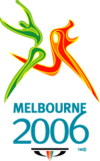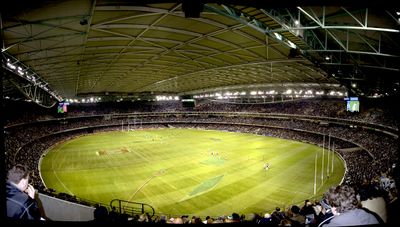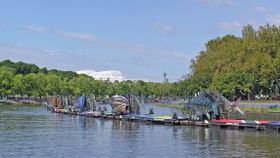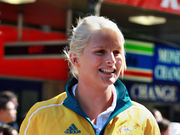2006 Commonwealth Games
| 18th Commonwealth Games | |
|---|---|
 |
|
| Host city | Melbourne, Victoria, Australia |
| Motto | United by the moment |
| Nations participating | 71[1] |
| Athletes participating | Approximately 4,500 |
| Events | 247 in 16 sports |
| Opening ceremony | 15 March 2006 |
| Closing ceremony | 26 March 2006 |
| Officially opened by | Queen Elizabeth II |
| Athlete's Oath | Adam Pine |
| Queen's Baton Final Runner | John Landy |
| Main Stadium | Melbourne Cricket Ground |
The 2006 Commonwealth Games were held in Melbourne, Victoria, Australia between 15 March and 26 March 2006. It was the largest sporting event to be staged in Melbourne, eclipsing the 1956 Summer Olympics in terms of the number of teams competing, athletes competing, and events being held.
The site for the opening and closing ceremonies was the Melbourne Cricket Ground which was also used during Melbourne's 1956 Olympic Games. The mascot for the games was Karak, a Red-tailed Black Cockatoo (a threatened species).[2]
Contents |
Organisation
Bidding
Cost and development
|
|
|---|
|
Early concerns arose about the large cost of staging the Games, with projected costs likely to be over 1 billion Australian dollars and a high likelihood the Victorian taxpayer would have to cover the expense. The cost was described in some local media as excessive. National Party leader Peter Ryan said that the Labor government should win "gold (medal) for burning money" [2] However, not all of this money was wasted. Prior to the Games, accountants at KPMG were estimating that the gross income generated by this event could be as high as 1.5 billion dollars.
Melbourne's premier sporting ground, the Melbourne Cricket Ground (MCG), was redeveloped in preparation for the Games. An athlete's village in the inner suburb of Parkville housed approximately 7,000 athletes and support staff during the Games, and has been transformed into commercial housing with a distinctly eco-friendly image. The creation of this village attracted controversy, with critics claiming it was created by alienating public parkland, while proponents maintained that it represented the renewal of an otherwise derelict inner-city area.[3]
The change from Daylight Saving Time to Standard Time in Australian states that follow it was delayed from 26 March to 2 April for 2006 to avoid affecting the games. In addition, state and private schools amended their usual term times so as to allow the first term holidays to coincide with the Games.[4]
Melbourne's public transport system - train, tram and bus - ran to altered timetables with some amended or substituted services for the duration of the Games. For the most part, timetabled services were unchanged but suffered due to higher loads.[5]
For the first time ever, the Melbourne 2006 Commonwealth Games appointed a Goodwill Partner, Plan International Australia.[6]
Venues
The following venues were used at the 2006 Commonwealth Games. The sport(s) which were played at that venue is listed after it.
Melbourne venues

- Docklands Precinct: Walks
- Melbourne Cricket Ground: Opening and Closing Ceremonies, and Athletics
- Melbourne Convention and Exhibition Centre: Badminton, Boxing and Weightlifting
- Melbourne Gun Club: Clay Target Shooting
- Melbourne International Shooting Club: Small Bore and Pistol Shooting
- Melbourne Sports and Aquatic Centre: Aquatics, Squash and Table tennis
- Multi Purpose Venue (Melbourne Park): Basketball Finals, Track Cycling and Netball Finals
- Rod Laver Arena (Melbourne Park): Gymnastics
- Royal Botanic Gardens Circuit: Cycling Road Race events
- State Lawn Bowls Centre: Lawn Bowls
- State Netball and Hockey Centre: Netball preliminaries and Hockey
- St Kilda Foreshore and Beach Road: Triathlon and Cycling Time Trial
- Telstra Dome: Rugby 7s
Regional and suburban venues
- Ballarat
- Ballarat Minerdome: Basketball with Tim O'Shea
- Bendigo
- Bendigo Stadium: Basketball
Wellsford Rifle Range: Full Bore Shooting - Geelong
- Geelong Arena: Basketball
- Lysterfield Park
- State Mountain Bike Course: Mountain Bike Cycling
- Traralgon
- Traralgon Sports Stadium: Basketball
Broadcasting
- The host broadcaster was Trans World International, while the domestic rights-holding broadcaster was the Nine Network in Australia. They showed rolling coverage, except for a break for the evening news and overnight.
- In Australia Fox Sports broadcast the Games on eight dedicated digital Pay-TV channels. These were available on the Foxtel, Austar and Optus Vision networks.
- The BBC covered the Commonwealth Games in the UK on BBC One and BBC Two. BBCi included a choice of two extra video streams on Freeview and four streams on Digital Satellite and Cable [3]. Users with Broadband in the UK could also view all 5 video streams on bbc.co.uk, and the BBC Sport website.
- CBC, CBC Newsworld, and CBC Country Canada aired a daily one-hour highlights show of the Commonwealth Games in Canada. Compared to past games, the CBC's coverage was minimally staffed, with commentary from other broadcasting partners. At first, they did not even consider bidding for the broadcasting rights [4] due to scheduling conflicts with events Canadians are more interested in, such as the Tim Hortons Brier, World Figure Skating Championships, and the 2006 Winter Paralympics (which itself had been reduced to five-to-ten minute daily coverage). None of Canada's metropolitan newspapers sent any journalists to report on the Games, instead relying on news agencies
- TVNZ covered the games for the residents of New Zealand
- In Malaysia, TV1 broadcast live coverage of the Games for three hours starting at 10 a.m. Malaysian time and for two hours starting at 3 p.m., with highlights at 12:30 a.m.. Astro also included 3 dedicated channels to broadcast the Games live & delayed broadcast 24 hours to it Sports package subscribers.
- Singapore's MediaCorp TV had supposedly not broadcast the games due to the high cost of telecast rights, satellite charges and the lack of sponsors. However, on 17 March, the MediaCorp found other sponsors which is the Ministry of Community Development, Youth and Sports and the Singapore Sports Council. Broadcast started from 18 March till the end of the games. [5]
- In the United States, selected coverage was carried by Fox College Sports
- Altogether an estimated 4 billion viewers watched the 2006 Commonwealth Games worldwide.
Calendar
| ● | Opening ceremony | ● | Event competitions | ● | Event finals | ● | Closing ceremony |
| March | 15th | 16th | 17th | 18th | 19th | 20th | 21st | 22nd | 23rd | 24th | 25th | 26th |
|---|---|---|---|---|---|---|---|---|---|---|---|---|
| Ceremonies | ● | ● | ||||||||||
| Athletics | ● | ● | ● | ● | ● | ● | ● | |||||
| Badminton | ● | ● | ● | ● | ● ● ● ● ● | ● ● ● ● ● | ● ● ● ● ● | ● ● ● ● ● | ● ● ● ● ● | ● ● ● ● ● | ● ● ● ● ● | |
| Basketball | ● ● | ● ● | ● ● | ● ● | ● ● | ● ● | ● ● | ● ● | ● | |||
| Boxing | ● ● | ● ● | ● ● | ● ● | ● ● | ● ● | ● | ● ● | ● ● | ● ● | ||
| Cycling | ● | ● | ● | ● | ● | ● | ● | ● | ||||
| Diving | ● | ● | ● | ● | ||||||||
| Gymnastics | ● | ● | ● ● | ●●●●● | ●●●●● | ●● | ● | ●●●● | ||||
| Hockey | ● | ● | ● | ● | ● | |||||||
| Lawn Bowls | ● | ● | ● | ● | ● ● | ● ● | ● | ● | ||||
| Netball | ● | ● | ||||||||||
| Rugby 7s | ● | ● | ||||||||||
| Shooting | ● | ● | ||||||||||
| Squash | ● | ● | ● | ● | ● | |||||||
| Swimming | ● | ● | ● | ● | ● | ● | ||||||
| Synchronised Swimming | ● | ● | ● | ● | ||||||||
| Table tennis | ● | ● | ● | ● | ||||||||
| Triathlon | ● | ● | ● | ● | ||||||||
| Weightlifting | ● | ● | ● | ● | ||||||||
| March | 15th | 16th | 17th | 18th | 19th | 20th | 21st | 22nd | 23rd | 24th | 25th | 26th |
Games
Opening ceremony
Both the Melbourne Cricket Ground and the Yarra River were centrepieces for the ceremony, which included many fireworks, and other spectacle. The Games were opened by Queen Elizabeth II, in her capacity as Head of the Commonwealth. The Queen is also Head of State of a number of Commonwealth countries, including Australia.
Sports

The 2006 Commonwealth Games included 16 sports, with 12 individual sports and 4 team sports. In total there are 247 events at the Games.
|
|
- The athletics, swimming, table tennis and weightlifting sports included fully integrated events for elite athletes with a disability (EAD). These events were included in the official medal tally.
Closing ceremony
Both the Melbourne Cricket Ground and the Yarra River were again centrepieces for the ceremony. Samresh Jung of India was given the David Dixon Award at the closing ceremony. He was the "Best Athlete of the 18th Commonwealth Games". The games were closed by HRH Prince Edward.
Medal table

| Rank | Nation | Gold | Silver | Bronze | Total |
|---|---|---|---|---|---|
| 1 | 84 | 69 | 69 | 222 | |
| 2 | 36 | 40 | 34 | 110 | |
| 3 | 26 | 29 | 31 | 86 | |
| 4 | 22 | 17 | 11 | 50 | |
| 5 | 12 | 13 | 13 | 38 | |
| 6 | 11 | 7 | 11 | 29 | |
| 7 | 10 | 4 | 8 | 22 | |
| 8 | 7 | 12 | 10 | 29 | |
| 9 | 6 | 12 | 13 | 31 | |
| 10 | 6 | 5 | 7 | 18 |
Participation
There were 71 countries, territories and bodies competing at the 2006 Commonwealth Games[7]. The only difference between the 2006 games and the 2002 games was the absence of Zimbabwe, which withdrew from the Commonwealth of Nations.
|
|
|
|
Missing athletes
On 20 March 2006 it was reported that two athletes had gone missing from the Commonwealth Games village: Tanzanian boxer Omari Idd Kimweri and Bangladeshi runner Mohammad Tawhidul Islam.[8][9]
On 22 March 2006 it was reported that seven athletes from Sierra Leone (three women and four men) had also disappeared. A further seven Sierra Leonean athletes also went missing during the course of the Games, bringing the total runaway count to fourteen (two thirds of the team). Victoria Police believed that they had fled to Sydney where the Sierra Leonean community is much larger than Melbourne's.
Two hours before the Closing Ceremony on 26 March, officials from the Cameroon team reported to police that nine of their members had also vanished.
These incidents were not without precedent: 27 athletes similarly disappeared from the 2002 Commonwealth Games in Manchester, England (21 from Sierra Leone, 5 from Bangladesh and one from Pakistan), and over 80 athletes and officials overstayed their visas after the 2000 Summer Olympics in Sydney.[10]
On request of Sierra Leone officials, the Commonwealth Games Federation cancelled those athletes' Games accreditation, allowing the Australian Department of Immigration and Multicultural Affairs (DIMA) to cancel their visas at midnight on 27 March, and begin investigating their disappearance.
At 7.20am on that day, New South Wales Police located six of the Sierra Leonean athletes in a house at Freshwater near Manly Beach in Sydney. All six indicated they wished to seek political asylum in Australia, and were granted bridging visas by DIMA while their refugee applications were arranged. The athletes claimed to have been subjected to violence and torture in their home country; seventeen-year-old Isha Conteh stated she could be forced into female genital cutting if she returned.[11] On Tuesday 28 March, six further Sierra Leoneans turned themselves in to immigration authorities in Sydney and were also granted bridging visas.[12]
Two of the missing Cameroon athletes were later found in Perth, Western Australia.
References
- ↑ The four Home Nations of the United Kingdom — England, Scotland, Wales and Northern Ireland — send separate teams to the Commonwealth Games, as do the three Crown Dependencies — Jersey, the Isle of Man and Guernsey — and 9 of the 14 British Overseas Territories. The Cook Islands and Niue, non-sovereign territories in free association with New Zealand, and Norfolk Island, an external territory of Australia, also compete separately. There are thus 53 members of the Commonwealth of Nations, but 71 competing teams at the Commonwealth Games.
- ↑ M2006 > Karak the Mascot > Display
- ↑ Battlelines drawn as Parkville site chosen
- ↑ http://www.det.vic.gov.au/det/schooled/schooldates.htm
- ↑ Public Transport
- ↑ Plan Australia
- ↑ [1]
- ↑ Whinnett, Ellen (22 March 2006). "Mystery of missing athletes". Herald Sun. http://heraldsun.news.com.au/common/story_page/0,5478,18556695%255E2862,00.html.
- ↑ "Nine athletes vanish from Commonwealth Games". Reuters. 22 March 2006. http://today.reuters.com/news/newsArticle.aspx?type=sportsNews&storyID=2006-03-23T042811Z_01_SYD317188_RTRUKOC_0_US-COMMONWEALTH-MISSING.xml&archived=False.
- ↑ "Athletes 'go missing from Games'". BBC News Online. 23 March 2006. http://news.bbc.co.uk/2/hi/asia-pacific/4835826.stm.
- ↑ ABC
- ↑ "Visas for second group of athletes". The Age. 28 March 2006. http://www.theage.com.au/news/national/visas-for-second-group-of-athletes/2006/03/28/1143441127017.html.
External links
| Wikinews has a related section:
Commonwealth Games
|
- Official websites
- Other sites
- 2006 Commonwealth Games at the Open Directory Project
- Melbourne marathon 1956-2006
- BBC coverage of Commonwealth Games
- 2006 Commonwealth Games - Australian Sports Commission
- Report on the Opening Ceremony - "Toronto Star", Canada
- CLEAN: - Website focusing on city preparation
- Sydneypinz - A Complete collection of pins used by the participating Nations at the Melbourne 2006 Commonwealth Games
- Culture Victoria – video, images and text about the 2006 Commonwealth Games
- Political opposition to the Games
- The Graffiti games 2006 - Backlash over the graffiti clean up in Melbourne before the games had even begun spawned its own website. [6]
- The Stolenwealth games - Website setup about the treatment of the Indigenous Australian stolen generation.
| Preceded by Manchester |
Commonwealth Games Host city |
Succeeded by Delhi |
|
||||||||||||||